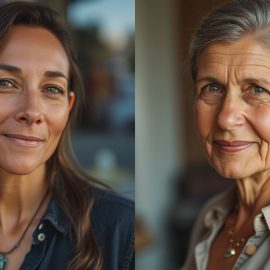

This article is an excerpt from the Shortform book guide to "Transcend" by Scott Barry Kaufman. Shortform has the world's best summaries and analyses of books you should be reading.
Like this article? Sign up for a free trial here.
What is Scott Barry Kaufman’s new hierarchy of needs? How has Maslow’s theory of needs changed over the years?
In Transcend, Scott Barry Kaufman offers a new hierarchy of needs, updating Abraham Maslow’s ideas about what people need to reach their full potential. He argues that Maslow’s “pyramid” is misunderstood, and his updated view is more in line with modern science and Maslow’s full body of work.
Read on to learn about Kaufman’s new hierarchy of needs, according to his book Transcend.
Kaufman’s New Hierarchy of Needs
In his book Transcend, psychologist Scott Barry Kaufman argues that modern neuroscience and psychological research support Abraham Maslow’s theories regarding deficiency and growth, and he thus bases his new hierarchy of needs on these two categories. Instead of deficiency needs, however, Kaufman uses the term security needs, noting that all deficiency needs are a form of insecurity, whether it be a lack of physical, emotional, social, or mental security. While his new hierarchy of needs also goes on to explain self-actualization and fulfilling your growth needs, in this article, we’ll specifically examine how Kaufman’s new hierarchy updates Maslow’s explanation of humans’ deficiency needs.
The Need to Feel Safe
Kaufman’s new hierarchy of needs claims that the most critical aspect of security is the need to feel safe, as it’s the foundation upon which all other needs are built. Satisfying this foundational need is vital for growth because if at any point this foundation is lost, your thoughts and behaviors will be dominated by the need to regain it. Kaufman breaks the need to feel safe into two categories: physical safety and emotional safety.
Physical Safety
The needs of physical safety include the physiological needs of food, warmth, shelter, and protection from harm. In modern society, this also includes financial security, as a stable income helps provide for all the other physical safety needs.
According to Kaufman’s new hierarchy of needs, the need for physical safety is tied to our need to understand and control our environment to achieve our goals. When we feel uncertain about our ability to do this, fears and anxieties arise, which get in the way of developing as a person—if you’re worried about how you’re going to put food on the table, you won’t have the time or energy to think about much else. It’s impossible, however, to understand everything around you and to be fully in control of your environment, so on top of maintaining a secure, stable life, you should also learn how to manage and respond to uncertainty.
(Shortform note: To regain control and reduce uncertainty in our lives and thus maintain the feeling of physical safety, psychologists recommend two things: implement structure in your life and be more empathetic. Structure can help manage uncertainty by giving us a sense of control over the things we can control. For example, when faced with uncertainty during the Covid-19 pandemic, the structure provided by mask ordinances and distance guidelines helped people navigate their daily lives. Empathy, on the other hand, helps people adapt to uncertainty when structure may not be enough. For example, if the changes brought on by the pandemic seemed overwhelming, giving and receiving empathy might have helped quell people’s anxieties.)
Emotional Safety
To achieve emotional safety, we need to feel safe with the people around us, and Kaufman argues that this begins with the development of a secure attachment style early in life. When you have a secure attachment style, you feel you have the trust, love, and support of the people closest to you, and you’ll have the confidence and energy to focus on other things, like exploring your environment or making new friends.
Kaufman points to research that shows that a secure attachment style sets you up for success and growth later in life. Studies show that those with a secure attachment style are better at regulating their thoughts and emotions and dealing with stress, are more satisfied in their relationships, and show heightened senses of empathy and tolerance.
When you’re an infant, you develop a secure attachment to your caregiver when you can rely on them to respond to your needs. As you grow older and develop more relationships, your emotional attachment style is also influenced by other attachment figures like romantic partners, close friends, siblings, or other family members. If you feel the people close to you have been sensitive to your wants and needs throughout your life, you’re likely to be a more trusting person and feel you’re worthy of love and support.
If you don’t feel as though friends or family members are sensitive to your wants and needs, you may develop an anxious or dismissive attachment style, which can hinder your ability to develop and maintain relationships. An anxious attachment style comes from a fear of abandonment and leads to a constant need for attention and reassurance. A dismissive attachment style also comes from fear of abandonment or rejection, but instead of being needy or reliant on those close to them, a dismissive person will avoid closeness or intimacy altogether.
The Need to Connect With Others
According to Kaufman’s new hierarchy of needs, once the needs for physical and emotional safety are met, people will feel a strong desire to connect with others. Our need to connect with others differs from our need for emotional safety, as it’s more than just the need to feel safe and protected; it’s the need to maintain close relationships as part of a larger group.
Community
Though connecting with others is more than just our need for safety, it did originate from our evolutionary need for social protection, writes Kaufman. Humans are social creatures, and close affiliations between small tribes or groups helped us gain resources and protected us from threats. The need to be part of a tribe or community was often a matter of life or death—if you were kicked out of the tribe, you probably weren’t going to survive much longer. Today, though most of us can survive without being part of a community, this psychological need remains strong.
People need to feel accepted within a group and, more importantly, to not be rejected. We’ve evolved to be highly sensitive to threats to our sense of belonging, and we’ve evolved painful emotions when we feel rejected. Most of us can easily pick up on subtle social cues when someone doesn’t like us, and we’re likely to feel emotions like jealousy or sadness as a result. If you feel lonely or ostracized, you’ll likely find this experience incredibly painful and it will be difficult to grow as a person.
The Need for Self-Esteem
The third major security need of Kaufman’s new hierarchy of needs is the need for self-esteem, which he defines as a sense of self-worth and confidence in your abilities. Your self-esteem largely depends on the other security needs of safety and connection—it’s difficult to feel valuable and confident if you don’t feel safe or accepted by others.
But the feelings of safety and acceptance from others don’t necessarily lead to self-esteem—it’s possible to feel safe and connected while still feeling inadequate. It’s also possible to mistake the vital need for self-esteem for unhealthy desires of superiority, power, and social status that accompany acceptance from others. However, if you feel safe and connected to others while maintaining a high opinion of yourself, you’ll have a strong foundation on which to build and grow as a person.
(Shortform note: The term self-esteem was first used in the field of psychology by William James, considered to be one of the founders of psychology as a scientific discipline. James provided a simple formula for self-esteem: self-esteem = success/pretensions. In other words, your self-esteem is dictated by your perceived level of success divided by your perceived potential. Thus, self-esteem, according to James, isn’t just about your successes, but how you view them. If you aren’t very successful but don’t have any pretensions about how much more successful you could be, you’ll have high self-esteem. If you’re successful but feel like you could be doing much better, you’ll have low self-esteem.)

———End of Preview———
Like what you just read? Read the rest of the world's best book summary and analysis of Scott Barry Kaufman's "Transcend" at Shortform.
Here's what you'll find in our full Transcend summary:
- An updated, modern take on Maslow’s hierarchy of human needs
- An in-depth look into Abraham Maslow’s full body of work
- How to simultaneously fulfill your needs while transcending beyond them






